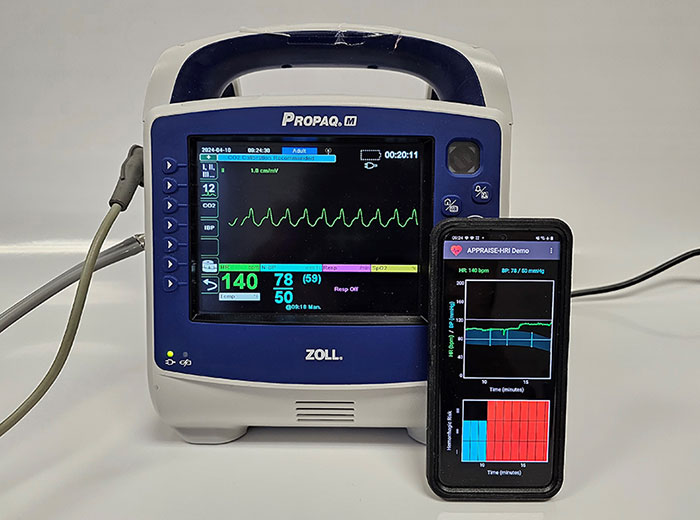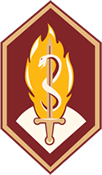FDA Clears First AI Software for Hemorrhage Triage of Combat Casualties

FORT DETRICK, Md. – The U.S. Food and Drug Administration has cleared a first-of-its-kind artificial intelligence-powered smartphone application developed by the U.S. Army Medical Research and Development Command's Biotechnology High Performance Computing Software Applications Institute that uses vital-sign data from trauma patients to assess their risk of hemorrhage. The clearance is a major milestone that allows MRDC to license the invention for use in military applications that could save the lives of trauma combat casualties who are at risk of massive blood loss.
The Automated Processing of the Physiological Registry for Assessment of Injury Severity Hemorrhage Risk Index, or APPRAISE-HRI, is the first triage system ever cleared by the FDA for assessing hemorrhage risk of trauma patients. It consists of an Android app that collects heart rate and blood pressure data received via Bluetooth from a patient's external vital-sign monitor and analyzes the pattern in these data to estimate the patient's potential risk of uncontrolled bleeding.
Over 90% of combat casualties die at or near the point of injury before they can be evacuated to a medical treatment facility. Furthermore, the primary cause of death among combat casualties is uncontrolled bleeding, which starves the brain and vital organs of the oxygen they need to survive. The APPRAISE-HRI application can stratify the risk of hemorrhage within 10 minutes, greatly assisting medics in triaging casualties in prolonged field care scenarios with limited resources in time to improve their chances of survival.
Dr. Jaques Reifman, senior research scientist and director of BHSAI, a division of Telemedicine and Advanced Technology Research Center, leads the team that developed, tested and obtained regulatory clearance for the APPRAISE-HRI application. He says the clearance represents the culmination of over two decades of hard work performing multiple clinical studies to collect enough high-quality data to train the AI algorithm so that it could produce results of a sufficiently high degree of reliability. The Defense Health Program and MRDC's Combat Casualty Care Research Program and Medical Materiel Development Activity sponsored the multiple phases of the research from inception to FDA clearance. The Henry M. Jackson Foundation for the Advancement of Military Medicine supported BHSAI's research.
"We conducted three clinical studies to collect real-world data on a total of about 2,000 trauma patients, which we used to train the AI algorithm," explains Reifman. "Some of the data were collected in austere environments – a moving ground or air ambulance and at the Emergency Department of the Massachusetts General Hospital in Boston. One of our biggest challenges was ensuring all that data were reliable and consistent."
MRDC's Office of Regulated Activities served as the regulatory liaison between Reifman's team and the FDA throughout the clearance process. ORA's team of regulatory affairs, compliance and clinical support professionals works with MRDC inventors to guide them successfully through the FDA review process to mitigate risk and accelerate the delivery of FDA-regulated medical products to Service Members.
"We had numerous interactions with the FDA reviewer throughout the review process and communicated regularly with Reifman's team to address FDA queries in a timely fashion," says Dr. Chandar Thakur, the chief of ORA's Medical Devices and Diagnostics Branch. "Dr. Reifman was able to address all the queries in a way that met the FDA's requirements, and the whole review and submission process went very well within the FDA's standard review deadlines."
To meet the FDA's strict requirements for clearance, the APPRAISE-HRI application was also independently and blindly validated in a clinical utility study that used vital-sign data collected from an additional 6,000 trauma patients at nine different sites. The study found that APPRAISE-HRI was highly effective in classifying patients into one of three risk categories based on their likelihood of experiencing a hemorrhage. Based on these results, the FDA concluded that that the APPRAISE-HRI application is "a useful tool to aid in discriminating hemorrhage risk in the trauma population."
"I feel a tremendous sense of accomplishment and am extremely proud of the work that we were able to do here," says Reifman, who received the Partnership for Public Service's Samuel J. Heyman Service to America Medal for Science and Environment in 2016 for his work on the APPRAISE-HRI. "It's not every day that you have an opportunity to go from an idea all the way to an FDA-cleared product."
With the granting of the FDA clearance, MRDC's Medical Technology Transfer Office is now actively seeking commercial partners interested in licensing APPRAISE-HRI for use in products that can be employed by military health care providers in the field. The DOD holds three U.S. patents related to APPRAISE-HRI. MTT uses its award-winning Assistive Technology Transfer process to help DOD inventors ensure that their new products are mature and military ready.
"APPRAISE has already attracted interest," says Blake Sajonia, an MTT licensing officer who has been working with Reifman and his team throughout the development of the application. "Two companies have expressed their desire to license it, and we expect that several others will seek licenses as well."
Sajonia says that the APPRAISE-HRI application will be one of the technologies available for licensing that MTT will highlight at its exhibit at the BIO International Convention June 3-6 in San Diego. BIO bills itself as the world's largest biotechnology event, attended by over 20,000 leaders from pharmaceutical and biotech companies, academia, government and the nonprofit sector.
Reifman said that of all the projects he's worked on throughout his career, the APPRAISE-HRI project was by far the most challenging and demanding — and also the most rewarding.
"I enjoy challenges and I believe this needed to be done," says Reifman. "Our Service Members put their lives at risk every day so that we can be safe, so why shouldn't I take a little risk myself by trying to do something to help them? If I only save one life, then all of this effort will have been worth it."














